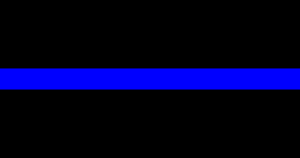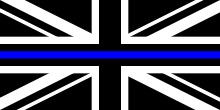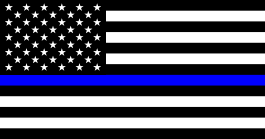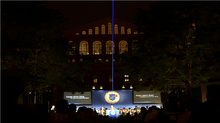Thin blue line
The Thin Blue Line is a phrase used by law enforcement. The phrase refers figuratively to the position of law enforcement in society as a bulwark between order and anomie, or between criminals and the potential victims of crime.
The term began as an allusion to the famous Thin Red Line, when a British regiment held off a Russian cavalry charge during the Crimean War.
History
The term is derived from the Thin Red Line, a formation of the 93rd Highland Regiment of Foot of the British Army at the Battle of Balaclava in 1854, in which the Highlanders stood their ground against a Russian cavalry charge.[1] This action was widely publicized by the press and became one of the most famous of the Crimean War.
The first known use of the phrase "thin blue line" is from a 1911 poem by Nels Dickmann Anderson, titled "The Thin Blue Line." In the poem, the phrase is used to refer to the United States Army, alluding to the Thin Red Line, and to the fact that US Army soldiers wore blue uniforms from the eighteenth century through the nineteenth century.[2][1]
It is unknown when the term was first used to refer to police. In the 1950s, LAPD Chief Bill Parker used the phrase in the department-produced television show of the same name.[3] Parker coined the term thin blue line to further reinforce the role of the LAPD. As Parker explained, the thin blue line, representing the LAPD, was the barrier between law and order and social and civil anarchy.[4]
The OED records its use in 1962 by the Sunday Times referring to police presence at an anti-nuclear demonstration.[5] The phrase is also documented in a 1965 pamphlet by the Massachusetts government, referring to its state police force, and in even earlier police reports of the NYPD. By the early 1970s, the term had spread to police departments across the United States.[1]
Use of the term became especially widespread following the release of Errol Morris' 1988 documentary film The Thin Blue Line, about the murder of a Dallas Police officer Robert W Wood.[1] Judge Don Metcalfe, who presided over the trial of Randall Adams, states in the film that prosecutor "Doug Mulder's final argument was one I'd never heard before: about the 'thin blue line' of police that separate the public from anarchy." The judge admitted to being deeply moved by the prosecutor's words, though the trial resulted in a wrongful conviction and death sentence.[6]
Symbols

Proponents say that the idea behind the various graphics that incorporate a thin blue line is that law enforcement is a Thin Blue Line that stands between chaos and order or between criminals and the potential victims of crime, and it is primarily used to show solidarity with police.[7] Opponents note that the representations of the public and the criminals as black bars on either side of the blue line are identical, and suggest that the symbology represents a police vs. everyone else mindset.[8]
Blue Line Identifier
The Blue Line Identifier, consisting of a single horizontal blue line on a black field, is a registered trademark of Blue Line Productions, Inc.[9] The Blue Line Identifier was developed by Blue Line Productions in 1993 and is used on a line of goods sold only to certified law enforcement officers.[10]
Variations


Various emblems portraying a Thin Blue Line have been made, including a horizontal thin blue line across a Union Jack rendered in black and white in the United Kingdom, or on a black and white American flag in the United States. The sale of badges and bracelets[11] with these emblems has been used to raise money for families of police officers that have died in the line of duty.
Due to the popularity of Thin Blue Line phrase for law enforcement, other various groups have derived their own "thin line" terms and emblems to represent themselves. Most notably, in the United States, the term The Thin Red Line has been adopted by firefighters as an analogy to the Thin Blue Line, despite the phrase originally referring to the British Army.[12]
Controversy

The "Thin Blue Line" has been controversial in both the US and the UK.
- In 2015, police officers in Sussex, England were told by their supervisors to remove a badge from their uniforms with a blue line across a union jack since it was not part of their official uniform. There was a concern that it could be seen as a political statement related to cutbacks in police forces.[13][14]
- In Chicago, in November 2016, counterprotesters carried the black and white US flag symbol to show support for police after a police shooting of Joshua Beal. The counterprotesters carried the symbol in confrontations with another group of protesters who felt the shooting was unjust and racially motivated.[15]
- The black and white US version of the flag with the Thin Blue Line is seen by many as a desecration of the official US flag but proponents argue that it is a completely different flag.[16]
- In Warwick, New York, the painting of a blue line down a roadway was protested by some citizens as being in opposition to the Black Lives Matter movement. The town has since painted the line red white and blue, the colors of the US flag.[17]
- In Riviera Beach, Florida, a group of police officers flew the thin blue line flags on their personal vehicles. They were ordered by their captain to remove the flags.[18]
- During the Unite the Right rally in Charlottesville in 2017, the thin blue line flag was used by white nationalist groups to symbolize support for police and opposition to the Black Lives Matter movement.[19][20]
- Multnomah County Courthouse removed the flag after it gained notoriety with the Charlottesville white supremacists.[21]
References
- 1 2 3 4 Day, Meagan (14 July 2016). "The problem with the 'thin blue line?' Cops aren't the army".
- ↑ "The Voice of the Infinite". Retrieved October 1, 2017.
- ↑ Shaw, David (25 May 1992). "Chief Parker Molded LAPD Image--Then Came the '60s : Police: Press treated officers as heroes until social upheaval prompted skepticism and confrontation". Los Angeles Times.
- ↑ Lasley, J. (2012). Los Angeles Police Department Meltdown: The fall of the professional reform model of policing. Boca Raton, Florida: Taylor & Francis. .
- ↑ "thin, adj., n., and adv.". OED Online. June 2018. Oxford University Press. http://www.oed.com/view/Entry/200782 (accessed June 29, 2018
- ↑ "Thin Blue Line: Interview Gallery". Errol Morris. Retrieved 2016-12-13.
- ↑ "Thousands Line Canonsburg Streets To Pay Final Respects To Fallen Officer". 16 November 2016.
- ↑ "The 'Thin Blue Line' Serves No Purpose". www.zerohedge.com. 2013-01-07. Retrieved 2017-08-24.
- ↑ "Registration No. 2,093,785". "Registration No. 2,990,630". "Registration No. 3,518,980". "Registration No. 3,728,422". "Registration No. 3,905,776". "Registration No. 3,234,257". "Registration No. 3,234,258". "Registration No. 4,064,078". "Registration No. 4,626,425". "Registration No. 4,630,054".
- ↑ "Blue Line Productions Welcome Page".
- ↑ USA, Thin Blue Line. "Company News". Thin Blue Line USA. Retrieved 2018-01-01.
- ↑ "Red Line of Courage". North Carolina Fallen Firefighters Foundation.
- ↑ Murray, James (12 October 2015). "Fury as police told not to wear UK flag badge in memory of colleagues killed". Daily Express.
- ↑ "Sussex PC told to remove union jack police charity badge". BBC News. 17 February 2015.
- ↑ Ludwig, Howard (November 20, 2016). "Three Groups of Protesters Come Face To Face in Mount Greenwood". DNAinfo.
- ↑ Phillips, Jack (12 July 2016). "'Thin Blue Line' Flags Appear Across the US". The Epoch Times.
- ↑ Bayne, Richard J. (December 6, 2016). "Blue line causes friction in Warwick". Times Herald-Record.
- ↑ Magnoli, Mike (March 14, 2017). "Thin Blue Line Flag controversy". WPEC.
- ↑ "Courthouse Removes Flag After White Supremacists Display It". U.S. News & World Report. Associated Press. August 25, 2017.
- ↑ Rossman, Sean (August 18, 2017). "'Thin Blue Line': What does an American flag with a blue line mean?". USA Today.
- ↑ Matsumoto, Samantha (August 25, 2017). "Ore. sheriff removes 'Thin Blue Line' flag from courthouse break room". The Oregonian. PoliceOne.
